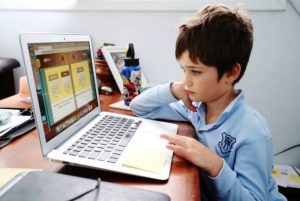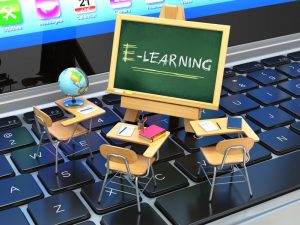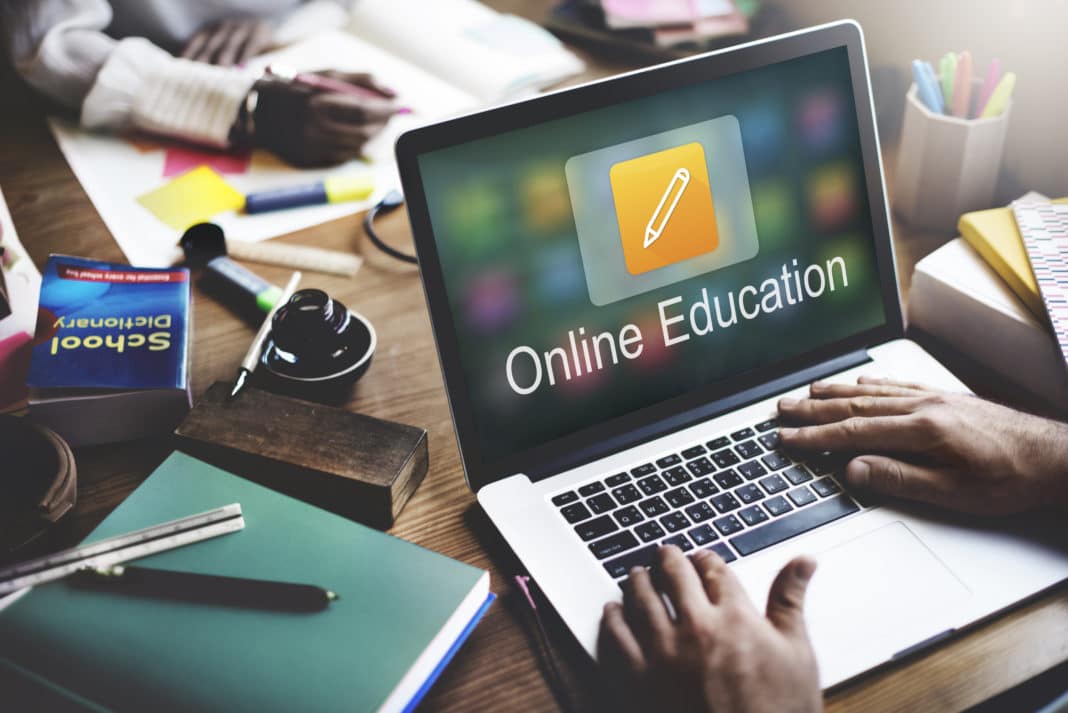Learning is like water and air, as the Dean of Arabic Literature Taha Hussein tells us, so life cannot be imagined without continuous learning, but after the corona epidemic and the social spacing it has become an alternative to going to schools, universities and different centers.
Everyone is wondering what this type of learning means, whether we’re going to be content with a wooden horse instead of the one we’ve been on the horizon, or whether we’re going to have a rich and different learning experience through electronic reality?!

distance learning-tb:others
And for more understanding of distance learning, UNESCO defines Distance Education as “an educational process in which all or most of the teaching is conducted by a person far from the learner, with the emphasis that most contacts between teachers and learners are made through a particular medium, whether electronic or printed”.
we also find the American Society for Distance Learning defined as “the process of acquiring knowledge and skills as an intermediate means of transporting education and information, including all kinds of technology and different forms of learning for distance learning.”
Distance Education may be synchronized, learners interact with the teacher at the same time, receive immediate responses, or be asynchronous and allow the student to interact with his or her lessons at any time without immediate reaction.
The online learning environment is often facilitated by learning management systems.
There are many different terms of distance education such as correspondence education, open education, distributed education, and there are other expressions, such as home or independent study, study from abroad, and also varied terms like distance learning or Remote Learning.
Elements of distance learning
In a book, Education Expert Dr. Cassia Rae, differentiates between this type of e-learning and its virtual education, through which an electronic curriculum and structure is adopted to support students enrolled in school, while distance learning uses electronic techniques to access the curriculum outside traditional classrooms, allowing for space between teacher and student; both communicate from home, usually during emergency times such as the outbreak of the Coved19 epidemic that we live in.

distance learning-tb others
The most important elements of this type of learning include time, communication, technology and lesson design;
Time:
It should fit the expectations of the teacher and the student, and include thinking about how many hours we can start, stop and divide times, sometimes teachers will want to communicate in real time, or simultaneously, with a student or groups of students. These types of communication can be made through video conferencing, chat or by phone. Apps like FaceTime, Google Hangouts, Skype, Microsoft Teams, Zoom, or What’s App can be used to provide these concurrent connections.
The concept of “office hour” can also be used so that many students can communicate in chat sessions simultaneously, allowing more touch points between teachers and students.
Communications:
Students should know exactly how and when to be expected to communicate with the teacher. Is email preferable to online chat? Should all communications be within the specific technology tool? What if this tool doesn’t work? What is the backup plan for communication? Each of these questions should be answered in an introductory document that sets out all expectations. You should think of the ideal ways to answer students’ queries around the clock.
Technology:
Technology can vary in improvised distance learning environments. If schools allow students to take home appliances, students must be willing to learn.
 Areas that are not usually involved in distance learning or virtual learning in their traditional calendars need to provide alternative ways for students to receive and return assignments; sending paper packages home and receiving them wrapped up is one way to continue studying during a crisis.
Areas that are not usually involved in distance learning or virtual learning in their traditional calendars need to provide alternative ways for students to receive and return assignments; sending paper packages home and receiving them wrapped up is one way to continue studying during a crisis.
Schools need to provide very clear information on how to access any online platform during distance learning, especially if students, parents and teachers do not use these tools on a regular basis. Technical support must also be provided throughout the province and not the responsibility of the teacher, who will have enough to keep up with the distance learning environment. Clear information describing troubleshooting steps and contact information for additional technical support should be readily available to everyone.
Lesson design:
The design of remote lessons is a little more detailed than creating the lesson to be explained within the classroom, the content must be very clear, and the teacher assumes that there will be a lack of understanding and thus add detailed explanations within the structure of the lesson.
 It is of the utmost importance to put activities, exercises and evaluation in the structure of the lesson, and to receive feedback from all students for the success of any lesson remotely, while reducing the study time and if it is common 45 minutes within the classroom, it will be approximately 20 minutes remotely, according to the book itself.
It is of the utmost importance to put activities, exercises and evaluation in the structure of the lesson, and to receive feedback from all students for the success of any lesson remotely, while reducing the study time and if it is common 45 minutes within the classroom, it will be approximately 20 minutes remotely, according to the book itself.
Principles of distance learning:
Distance learning is based on a number of principles, the most important of which are (according to Suzanne al-Mahdi):
- An individual process: the educational process must be designed in a way that corresponds to the individual’s readiness, abilities, inclinations, trends and speed in learning.
- Subjective: Learning with the self-desire and motivation of the learner.
- – Continuous: education is a lifelong process that may wish to develop oneself professionally, scientifically or culturally, and must be given the opportunity to achieve this, at any time, anywhere.
- Independent: that is, the learner should learn on his own, often on his own.
- . Democratic: in the sense that education is the right of every member of society regardless of colour, gender, race, religion, circumstances and age.
In The Learner’s Psyche
 Experts emphasize that learning is influenced by the content and educational strategy in educational materials more than the type of technology used to deliver education, as Terry Anderson puts it in the first chapter of his famous book “E-Learning”, several theories that suggest the same thing, such as the saying “Kuzma” : it is not the computer that makes students learn, but the design of real-life models and simulations, and the interaction of students with those models.
Experts emphasize that learning is influenced by the content and educational strategy in educational materials more than the type of technology used to deliver education, as Terry Anderson puts it in the first chapter of his famous book “E-Learning”, several theories that suggest the same thing, such as the saying “Kuzma” : it is not the computer that makes students learn, but the design of real-life models and simulations, and the interaction of students with those models.
Dr.Siemens proposes to involve learners in the search for information to build a true and ideal knowledge base in a web-based world; information may not be derived from a single source, certified, but collected from different entities, a method that must be strongly adopted in distance learning.
From the point of view of cognitive psychology, according to the same book, we will see that learning is a process involving memory, thinking, abstraction and motivation and the learner uses different types of intelligence and memory during learning, and sensations are received through the senses as well, and if you want a creative education remotely, you must awaken all those senses and intelligences in the learner.
More precisely, the duration in the working memory is approximately 20 seconds, and if the information is not pro-boot efficiently, it is not transferred to a long-term memory of storage and then placed in comparison with the previous knowledge models to be understood, and these and other things give us a background to the value of careful processing of the educational content provided remotely.
Andersen’s book points to the importance of using a variety of educational activities to accommodate different learning styles.
Experts advise you to create a commitment environment within the distance learning group, and to impose rules of affiliation, as this enhances and helps the learning process, as well as constantly creating a challenge for the largest number of participants, while rewarding people with the best ratings, titles, certificates and the like.
An indispensable opportunity
In his book, Andersen points out that distance education will remain the most hopeful antidote to the mistakes of greed, ignorance and aggression that threaten our world.

tb: others
Distance learning has become an indispensable opportunity not only for students to acquire different knowledge with greater flexibility, efficiency, less cost, or even job-related jobs, but also for employers and the economy of nations within the so-called “new knowledge economy”, and all institutions have already been locked in a frantic race to book their rightful place on the map of programs and curricula offered “remotely”.
Due to the current popularity of this type of learning, the role of the teacher has gradually shifted to the likes of a maestro to brainstorm the topic of the lecture, not the teacher of the fixed curriculum, where trainees and students share what they have read within the framework of well-received programs and plan, and therefore the educational criteria, which also include evaluation criteria, have evolved.
This pattern has also encouraged the so-called “democracy of knowledge” and made it available to marginalized, disadvantaged or people with special needs.
MOOCs rooms and video lectures have been transformed into a practical alternative to many face-to-face lectures, especially since they are a system that allows the freedom to learn in a timely manner for the student, known as “asynchronous” learning, and according to (Kaplan and Helen, in an academic article on the “Wayback Machine”)this rooms expected to integrate social media applications and user-generated content in offline classes as well. Microblogging apps like Twitter should turn to expand discussions outside the classroom and allow students to share or tweet their reactions to reading tasks.
There are many justifications for distance learning, which has become a necessity and not a luxury after the outbreak of the new coronavirus in our world today, according to Dr. Salah Al-Sharhan in his study on “Open Education and Distance Learning in the Arab World”, the most important of which are:
* Global trends by adopting open education, which is a driver for the economies of countries.
Social and cultural justifications (providing the opportunity to learn for those who have not had the luck to attend university, those who are unable to leave their home or work, and the possibility of combining academic achievement with work.
* Human and geographical justifications: absorbing large numbers beyond the capacity of traditional universities are the most important features of distance learning, with the ability to refine the experiences of trainees and provide them with better opportunities in the labor market.
*Humanitarian and psychological justifications: Distance learning makes the right to learn one and is accessible to all, it is less expensive than its traditional counterpart, more suitable for wider segments, and it improves one’s level in society and makes it more up-to-date with the new developments of the times.
Economic justifications: Distance learning is the least expensive per capita and the highest is due to society and to drive the economy.
Political justifications: This pattern of instability and political unrest is the best option, especially when educational institutions and universities are closed.





